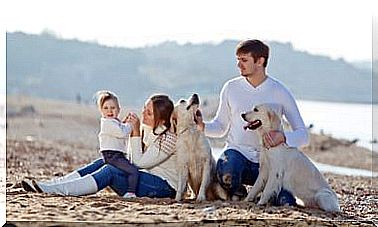Challenges That We Find In The Education Of Canine Behavior

It is often believed that dogs of a certain age cannot ‘learn anything new’ and that only puppies can receive training. Nothing further from reality. However, there are some challenges that we find in the education of canine behavior that are worth identifying to reverse the situation.
Canine Behavior Education: What Causes Bad Behaviors
Whether we are trainers or we simply want our pet to behave correctly, we can face certain challenges during canine behavior education.
Knowing the dog in question is essential to achieve good results and that the teachings are maintained over time. Also, patience and commitment are vital to avoid behavioral problems in animals. Each one has their times to learn and to assimilate new orders.
Behavioral problems in dogs can be caused by many reasons and appear at any time in their life, although most strongly in childhood. We cannot ignore genetics –some breeds are more prone to disobey, such as the Afghan greyhound or chow chow– or the situations that the animal went through.
If a female dog is very skittish because she lives on the streets, her puppies probably have that ‘defect’ even when they have been adopted. If an animal has been punished by its former owners, it is more likely to try to attack or hide in the presence of certain objects that remind it of its trauma.
In turn, we must take into account the socialization of the dog. This plays a very important role in their behavior. Those dogs that have not had contact with other animals as puppies can be more fearful, more nervous and more disobedient.
Main challenges in the education of canine behavior
When we want to teach our pet and give him certain orders, it is necessary to know him well and know about his past, even when he is a small puppy that has just arrived home. Knowing about their history can help us and prevent certain behaviors that hinder the education of canine behavior. The main behavior problems in dogs are:
1. Aggression
It appears before other animals or towards people. First it growls, then it barks, and finally it tries to bite. An aggressive dog can be a problem around young children or other pets, as he becomes a constant danger.

In addition, by presenting this characteristic they are more likely to be ‘disowned’ or left aside by their owners or animals in different settings (home, park, beach, etc).
2. Fear
It can be before a person, an action, a situation, another dog or even an object. Fear arises as a reaction to past trauma, but it also appears in animals that have always ‘been treated well’.

Lack of habit, change of home or some illness can increase fears in dogs. The most frequent fears are: loud noises (storms, fireworks, horns), contact with other dogs and with objects such as sticks or the like that remind him of blows from the past.
3. Hyperactivity
It is true that some breeds are considered more active than others (e.g. a Dalmatian or a Beagle move more than a Saint Bernard), which is challenging for those attempting canine behavior education.

A hyperactive dog, in addition to not staying still for a minute, needs more play spaces and exercise to discharge energy. If this does not happen, they can bite or destroy everything at home.
4. Separation anxiety
This is a recurring problem in the education of canine behavior, since it is based on the habits of their owners. Separation anxiety appears when the animal is alone in the home and can be experienced in different ways : destruction of toys and objects, barking, crying, scratching on doors, urinating all over the place, etc.

The challenges in terms of canine behavior education that trainers and trainers face are many more, but these are the most common and in which they usually work.









